Welcome back… me – and all of us really!
It’s been a few years since I last posted, which, you might notice, roughly coincides with the recent COVID pandemic. During that time I was completely burned out on costume. About the only things I’ve sewn since late 2019 have been mending projects. I needed an escape, but instead pretty much spent my days going to work, as usual, avoiding the presence of my coworkers at the same time, and doom scrolling! Such was the life of many an essential industry worker.
Some people took their enforced confinement time to work on costumes, but I started to hate them (costumes, that is). I didn’t see a point for myself. That said, I did still enjoy watching what others were doing and now can better appreciate all the time and enthusiasm they poured into their projects.
This year I’ve had the great fortune to spend time with my renaissance guild, both in and outside of faire. Somehow I seem to have gotten my costume mojo back. I’ve been researching for a couple different, related, projects. I also completed a nominally period-ish looking tent coverup for one of those screen houses (and repairs to the screen house itself). Now that I know the structure can take the canvas weight, I plan to redo it in a way that will make set up and tear down easier, not to mention make looking a bit more period. But more on that later.
This year, I’ve tentative plans for:
- the above mentioned mini pavilion revamp
- a revamp of our main guild pavilion – it’s shrunk and my method of attaching the walls and roof, while secure, make it tedious to put up
- two Elizabethan tall hats
- detailed instructions for someone else to make an Elizabethan tall hat (done)
- a new lower to lower-middle class costume for myself, likely including: a supportive kirtle, gown, partlet, new smock. I do have a good smock and existing sleeves, so those may or may not happen
- helping a couple other people with their new kirtles/gowns
- helping some guildies with other costume upgrades
- a tabard for our new guild herald, possibly a couple more
- possibly a new Dickens costume??? I don’t know
- finishing a long running, oft put down, crochet project and, as a reward, starting probably one of the most ambitious crochet projects I’ve ever considered. Which will undoubtedly take me years, the way I tend to get distracted…
- I think I’m back for Halloween too and my current plans involve at least one big prop build
Now to the meat of this post!
As I was helping a friend source materials for making an Elizabethan tall hat, I discovered that buckram is even harder to come by than it used to be. There is one source that makes their own period stuff and they mentioned that it can be made with hide glue (eww, but maybe). Additionally, it can be made with tragacanth or xanthan gum, the latter of which was actually discovered in the 1960s, but really, I don’t care. I also have it on hand, so…
EXPERIMENT TIME!
Goal: To make my own buckram, essentially on demand
My Theory: That either the roughest weave or the double fill will be the stiffest, given the same application of gel to all fabrics.
Items Needed: hot water, xantham gum powder, a measuring spoon, measuring cup, mixing container with lid, natural bristle brush, cutting board or other surface that won’t transfer color to fabric and fabric samples. Fabric note: a rougher weave is suggested.
Fabrics I Used:
- a fairly heavy mystery “linen” donation fabric that is a double fill, in a natural color. I’m guessing it’s in the 6.5oz range
- a dark blue linen at 5.3 oz
- a dark rust color linen that is likely 7.3 oz and seems a little rougher weave
- a dark brown linen that is 7.1 oz
- a no. 12 cotton duck (11.5oz fabric with a double fill) in natural
- an 8oz cotton painter’s drop cloth
Prep:
- Cut two samples of each fabric, one to test and one as a control. Originally I was only going to use only the first four, but added the others on the second day.
- Mix together a half teaspoon xanthan gum with a half cup of hot water. Mix like crazy to avoid lumps, or be lazy like me and use one of those little hand held milk frothers. Incidentally, the instructions said to use a cup of hot water. Not sure why I used a half cup. I don’t expect leftovers to last in the fridge for more than a couple days since I used tap water, which contains living organisms.
General Procedure:
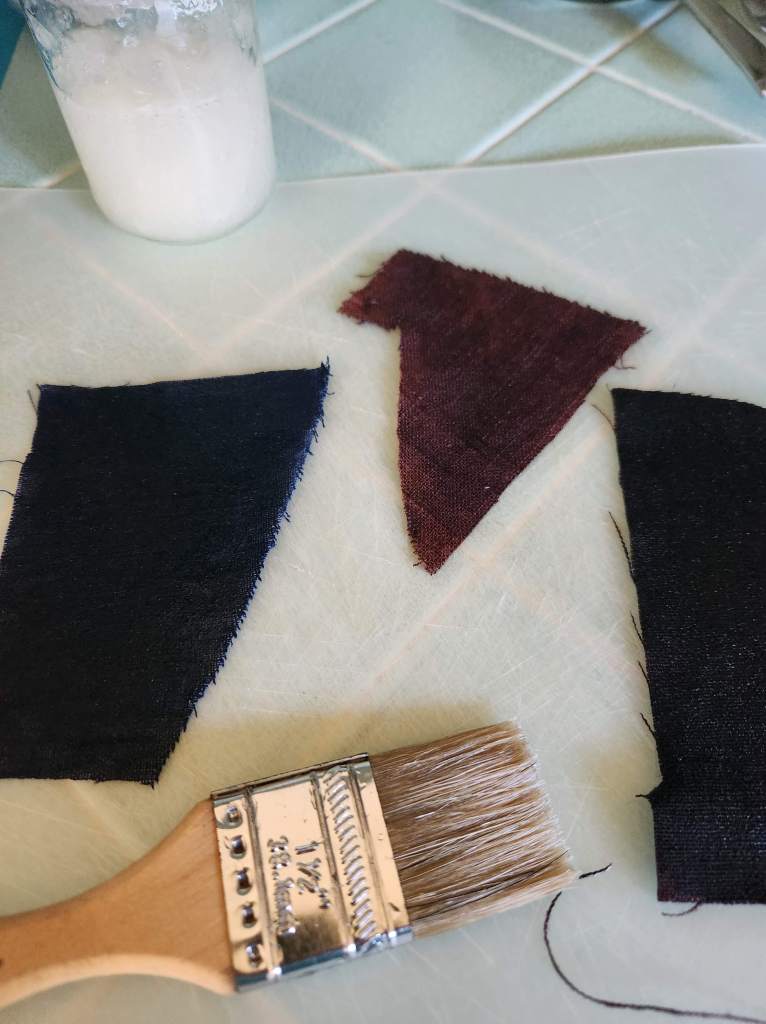
- On a waterproof surface (the cutting board, in this case), apply the mix with your brush to one side, working it into the weave with the bristles.
- Once dry, repeat process on the second side.
- Repeat to make stiffer.
What I did:
After my initial application [to only the first 4 listed fabrics] I put my samples out in the late afternoon sun to dry. After an hour they were all dry. They were probably dry sooner but I didn’t check earlier since I had a cat on my lap. Interestingly, the double fill fabric curled up a bit at the edges. The others all stayed flat. Each of the fabrics definitely had increased stiffness. I applied a coat to the second side only, again working in a bit. I do you feel like I used a little bit more gel this time. I put them back outside to dry.
An hour later the fabrics weren’t quite dry. I could still see some moisture in the middle areas, particularly on the one that seems the thinnest (the blue), but it was stuck down to the plastic cutting board pretty thoroughly. When I lay them out during the initial round, I had pulled them off the cutting board so they weren’t completely stuck but, as I said, I think I used more a mixture on them in application two.
After another hour they were dry. They were stiffer, but not anything like the commercial heavy buckram I have. That has a loser weave with thicker yarns. I decided to continue the project to the next day because it was getting later and cooler.
The next morning, I applied a gloppy layer to the samples and, once again, tried to work it into the fabric with the brush bristles. Additionally, I got the two samples of cotton canvas. I dipped both of those so both sides were completely coated and worked the mixture into the fibers with my fingers, then wiped off the excess. They all went out into the morning sun to dry.
Side note. The reason you don’t just dunk the fabric in the gel squeeze out the excess is because you risk wrinkling the fabric. I can see it working if you use a squeegee to remove the excess instead.
An hour later, the original brushed samples were dry. I brushed a coat on to second side. The dunked samples were still damp.
An hour later, the original samples were dry and complete for this test. Of the two cotton samples, the heavier double fill was dry, but the lighter weight looser weave was slightly damp. I coated the first side of both of them for a second time with the brush.
Another hour later, and the two cotton samples were dry. It was warmer today, probably about 75°, and there was a little wind. I coated the other side of the two cotton samples one last time.
An hour later, all my samples were dry. The double fill had continued to curl a bit. I’m now questioning if it’s linen or not. It was a donation. A burn test will at least ensure it’s natural fibers. [Not done yet].
Evaluation
I’ve taken photos of the before and after, holding each of them on their edges or points in a way so you can see how much or little they drape, for both the untreated and test pieces. I’m also holding them so you can see how much light passes through the weave of the stiffened version.
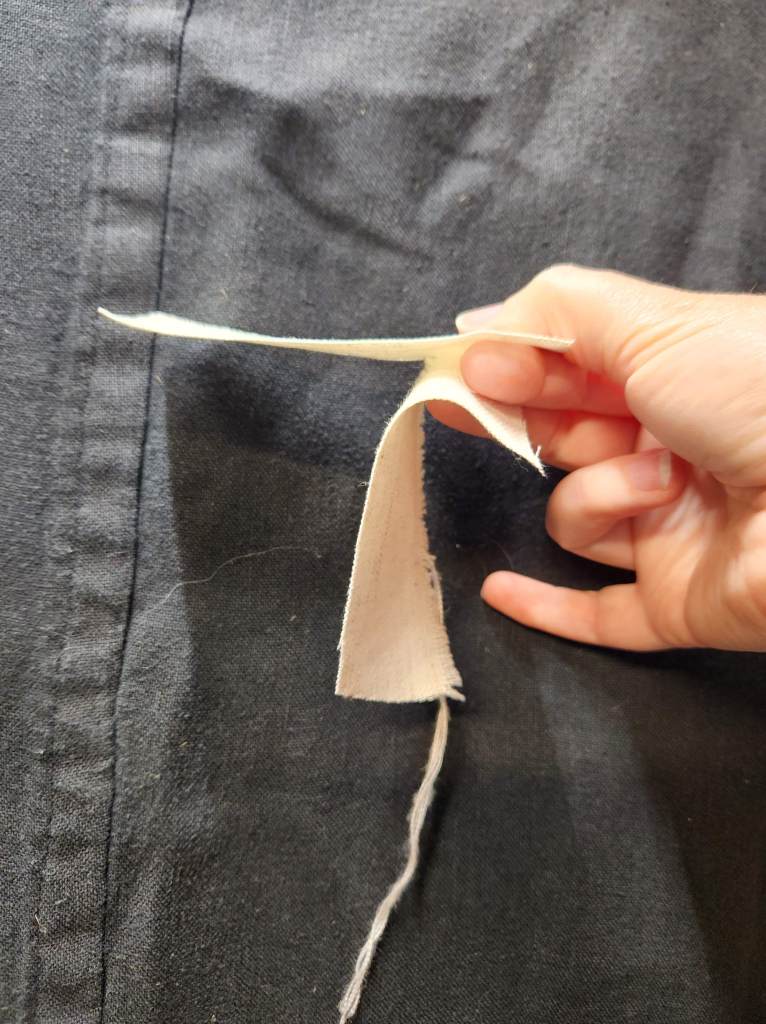
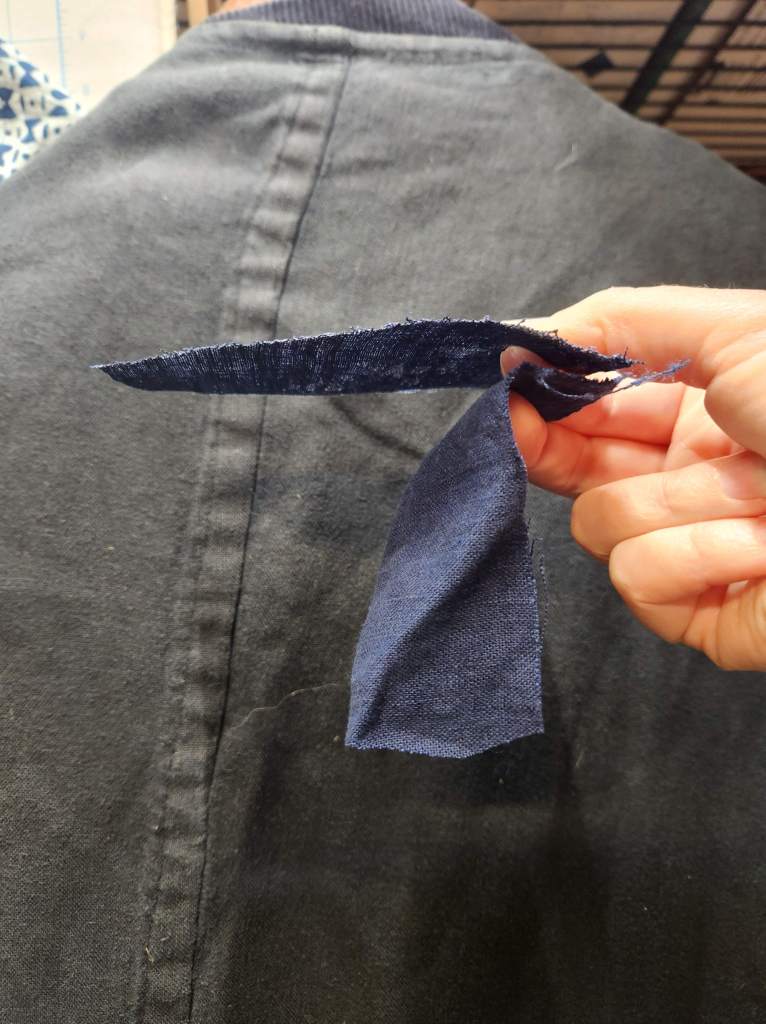
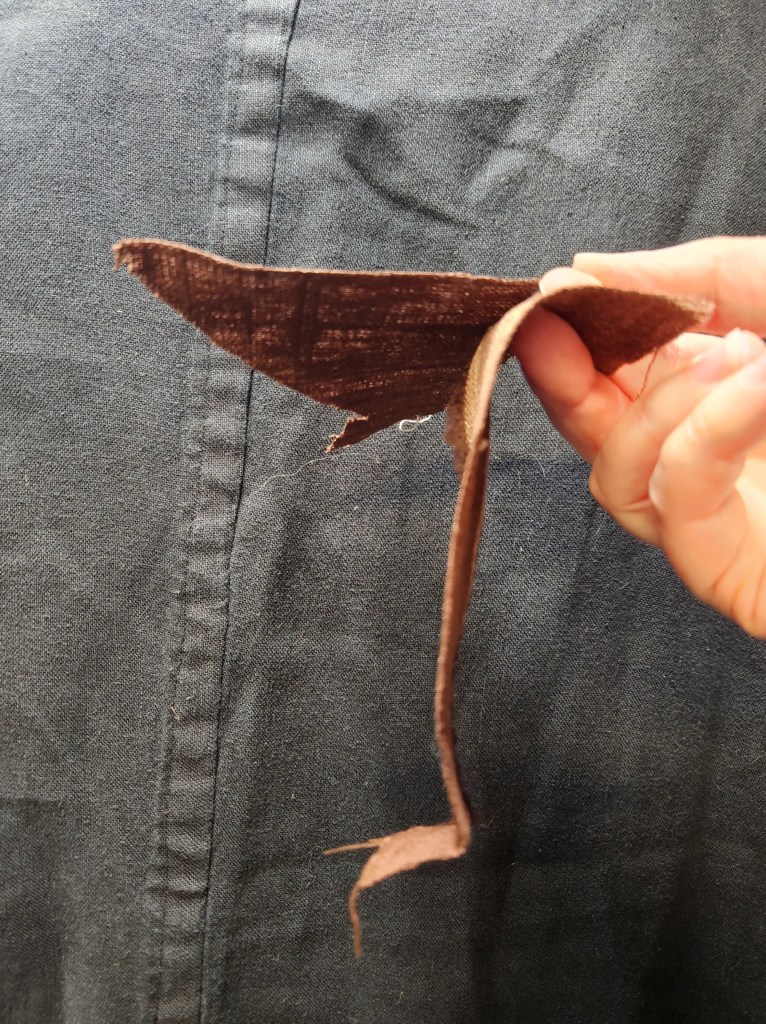

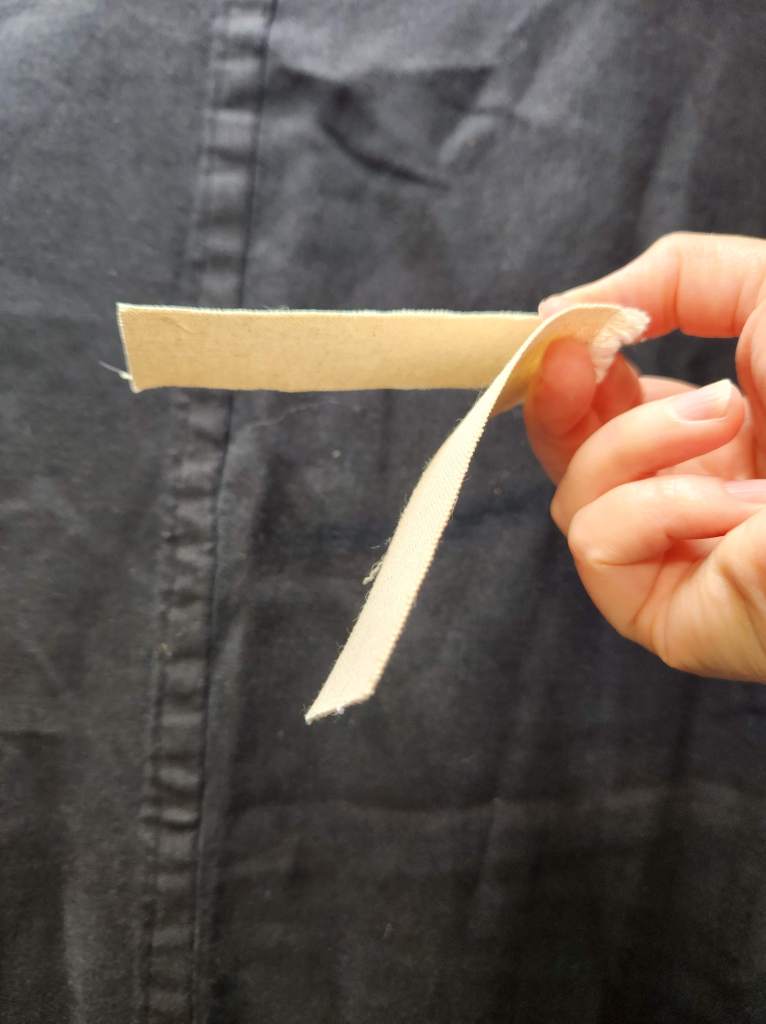
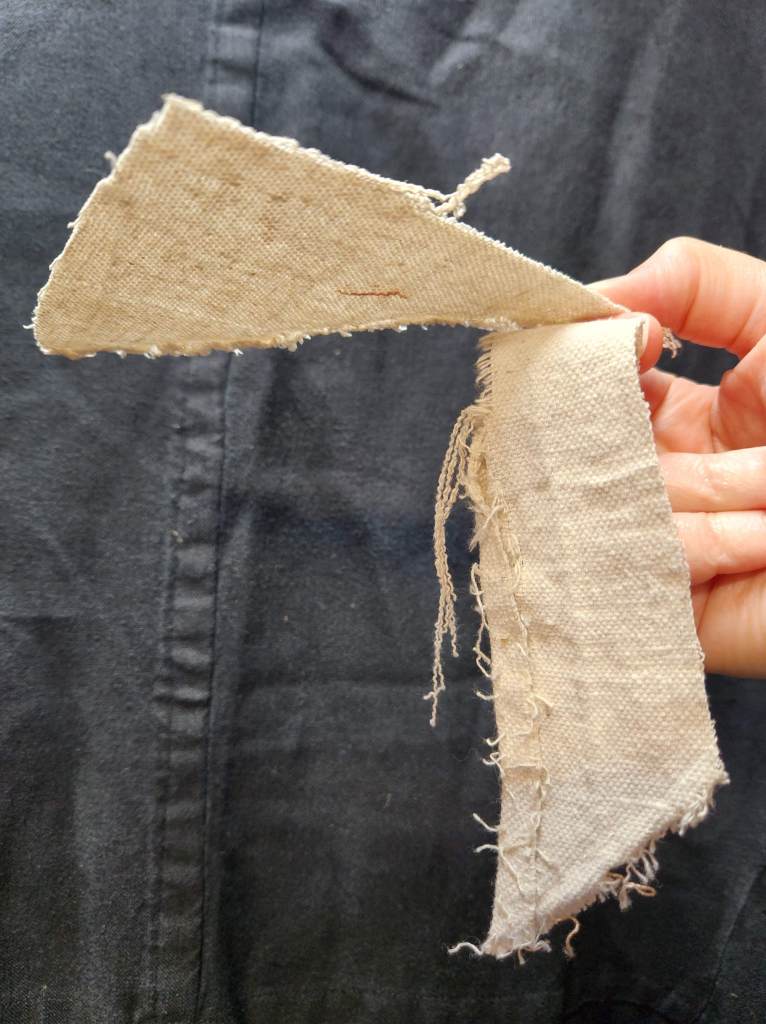
Don’t be fooled by the drop cloth. My angle is different; it’s actually drooping.
The duck is a big question really, it’s already stiffer because it’s a tight double fill. I’ve used it as an interlining before, but also made a pavilion out of it. Treated it feels rather soft. I wonder if that means it could handle more stiffening gel?
The one that feels the sturdiest to me is the rust, I believe 7.3 oz. It is a rougher weave or at least the roughest I have. I’ve also compared it to the commercial heavy buckram I have and you can see that there’s a great difference. You can see whatever it’s stiffener is in the weave gaps. I don’t know what the commercial stuff is stiffened with, but the substrate should be cotton.

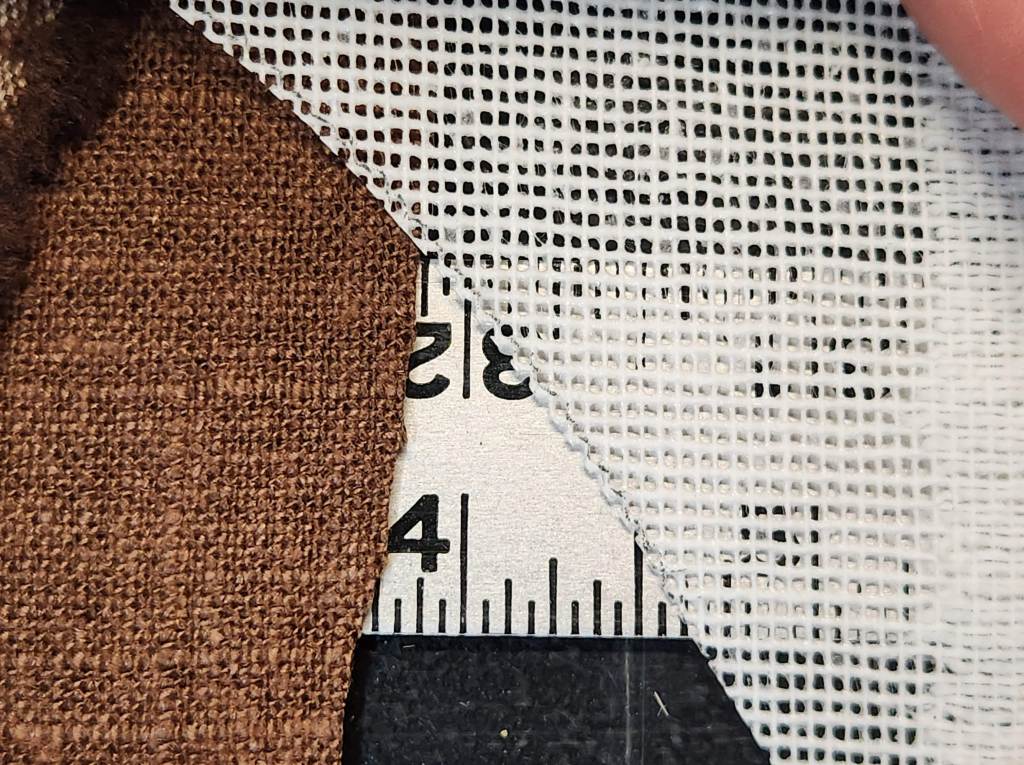
The blue, which is a tad see through, is also rather stiff. It could have some uses.
The overall difference in stiffness appears to have more to do with the structure of the weave, then the thickness of the yarns, than it does the given ounces or perceived weight of the samples.
Next Steps
I would like to get something with a looser weave with a heavier yarn size and try this again. I can definitely see the potential use in making my own buckram. I know of one source that carries a loose “open” weave linen, though it’s only 5 oz, so the yarns are smaller than the commercial heavy buckram. I would also consider trying hide glue.
The big question currently is: is any of what I made acceptable for stiffening my Elizabethan kirtle? If I’m going by the standards of modern heavy buckram the answer is no. But is that the appropriate standard?
_______________________________________________
Edit the next day: Additional Thoughts
I’ve got at least one other substrate idea to try out. And then there’s the stiffener. I said, “why not?” when I realized I had xanthan gum on hand, but now I have some specific negatives to research. Here is a quote from Reddit user “Reep1611” from this thread (bold added for emphasis):
“…Xanthan while also being a polysaccharide acts different [than tragacanth or arabic gums]. Where Gum Tragacanth and Arabic when dissolved in water thicken it to a moderate degree and create a quiet sticky liquid with a not too small amount of them being dissolved, Xanthan is an extremely effective thickening agent. That means there is a lot less dissolved into the water, and such a lot less of it in the buckram. It also is not too sticky. That means that it’s capability to stiffen is a lot lower. Add in that it tends to dry somewhat powedery and brittle and the buckram is softer, needs more treatments, has somewhat different properties and a tendency to loose it’s stiffness when worn and put under stress. And because Xanthan dissolves into a gloopy mass, and not like a thin syrup, it also has a much harder time penetrating the weave and in between the fibres. Which also makes it more fragile.
Then we come to another point. Both Gum Tragacanth and Arabic have strong antibacterial and fungal properties. Even if it’s a bit more moist, they don’t really do anything. But Xanthan, due to being extremely hydrophilic, loves to suck moisture from the air. The trouble is that it is a pure polysaccharide, basically a long complex sugar with none of the additional substances in the natural gums. So there is nothing stopping bacteria and fungi from eating it. I actually had mould grow on some of my Xanthan buckram after a particularly moist and rainy week.“
So…. experiment TBC… Runs off to do more research and find Gum Arabic.
Leave a comment